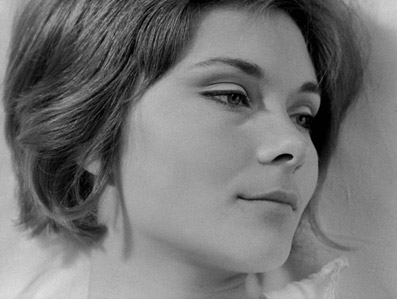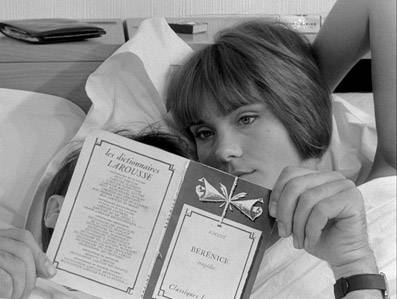|
I have a fondness for film titles at both ends of the clarity spectrum, those that either give you no idea what the film is about or those that spell it out in unambiguous detail. 50s American science fiction movies were great at this – Invasion of the Body Snatchers, It Came From Outer Space and everyone's favourite, Attack of the 50-Foot Woman – and the longer the title the more intrigued I become. Which is why from the moment I heard that there was a play and a film titled The Persecution and Assassination of Jean-Paul Marat as Performed by the Inmates of the Asylum of Charenton Under the Direction of The Marquis de Sade it went straight to the top of my Must See list. And if you haven't seen it then you should – it's an extraordinary play and a mesmerising film.

Not being quite as hooked on the work of Jean-Luc Godard as some others, I'd never seen his intriguingly titled Une femme mariée: Suite de fragments d'un film tourné en 1964 en noir et blanc – which for non-French speakers translates as A Married Woman: Continuation of Fragments of a Film Shot in 1964 in Black and White – until the review DVD landed on my doorstep back in April of last year. I didn't know what to expect and was repeatedly surprised by what I got. I was left in two minds by the film as a whole, which for me played more as a sketchbook of ideas – a creative and sometimes exciting one without question – than the fully realised work it has been championed as elsewhere.
You can read the original review here.
For the most part I'd stand by the views expressed in that review, but will admit that I've since grown rather fond of the film's sketchpad structure and its refusal to neatly tie up the narrative or settle on a particular style. This does ensure it's only going to work for a specific audience, of course, but that's exactly the sort of film we like to champion here. I'm happy to put aside issues of personal taste to recommend you see it anyway, as it's still way more adventurous than the majority of the current mainstream and even indie fare, and its experimentation always feels like the work of an artist exploring his craft rather than an attempt to draw attention to the practitioner. Godard devotees will likely love it, and those with a taste for the offbeat and experimental should find plenty to tickle their palettes. Certainly if you're looking to clear your living room of Hollywood action junkies then Une Femme mariée, with its non-widescreen monochrome imagery, French dialogue, long-held shots, intellectual debates, structural game-playing and rejection of standard storytelling arcs, has all the components needed to send them scurrying.
The bar for fine transfers of older films has been raised since they began appearing on Blu-ray, and what I last year commended as a fine DVD transfer has just nine months later been edged into second place by its high-def replacement. The 2009 DVD and this new Blu-ray were clearly sourced from the same high-def original, evidenced by the identical small instances of damage found on both. But comparing the two transfers side-by-side, the increased sharpness offered by the Blu-ray is clearly visible, particularly in the texture of clothing and the detail on signage on wide exteriors, with lettering clearly legible here that is blurred on the DVD. The contrast is also a shade more subtle than on the standard def disc, providing more detail in darker areas without losing the blacks to grey. The film grain is still clearly visible but a little less prominent, and the slight flickering of brightness found on the DVD is also still present. As so often with the better HD transfers, the increased resolution gives an an almost tactile feel to some textures and surfaces, notably the paintwork of cars (just why this always looks so good I've yet to work out), clothing and facial close-ups.

click here for a full sized screen grab
The PCM 48 mono track does not differ greatly from the Dolby mono 2.0 track on the DVD, with the same restrictions in dynamic range and volume, but also its clarity and absence of damage and noise.
Like the DVD, there's only one on-disc extra, and that's the Original French Trailer by Godard (3:47), which you can read about in the DVD review, though here is presented 1080p at 24fps.
Though not included with the preview disc, the original Booklet is also included with the release disc, a substantial inclusion and a fascinating read that may well include updated technical details for the Blu-ray transfer.
If you have the Masters of Cinema DVD then the decision to upgrade will be down to the picture quality upgrade, and whether you believe that justifies the asking price will depend on how highly you rate the film itself and how much cash you have in your disc fund box. If you don't own the DVD then the Blu-ray is definitely the one to go for, as the improved sharpness and tonal range really do add to the film's sometimes striking visual appeal.
|